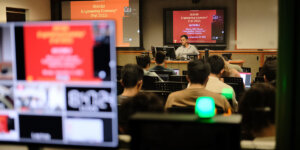
Photo Credit: shutjane/Getty Images
The Internet
In 1972, just as USC’s Information Sciences Institute (ISI) was being established, scientists around the country were connecting remote computers from different organizations, forming what would eventually become “the Internet.” This put the researchers at ISI in the perfect position to jump right into the wild new world of networked computers. Establishing the internet’s inner workings with Request for Comments (RFCs); creating the “phonebook” of the internet with the Domain Naming System (DNS); building out the system of “dots” to divide the internet into .com, .edu, org, and more; developing the rules of the road with internet protocols (IPs) – these are just some of the dizzying array of internet developments made at ISI that are still used today.
Portable Computing
A portable computing device that connects to a network – sound familiar? In 1974 laptops didn’t exist, so the researchers at ISI were a bit ahead of their time when they created the first portable remote-access terminal. At the time, remote access terminals (the hardware used to connect a user to a network) were large and cumbersome. The terminal developed at ISI was the size of a shoebox, and it was so innovative and handy that it was used by the director of the Defense Advanced Research Projects Agency (DARPA) – the agency shepherding the burgeoning ARPAnet (forerunner of the internet).
Smartphones
Back in 1979 there were no smartphones, however thanks to ISI, there was the first packet radio terminal. This was a portable system for communicating by radio with the help of a keyboard and display screen. Sounds a little bit like a smartphone! Tom Ellis, one of the founders of ISI, led a team in the development of the first packet radio terminal which would, in fact, be a precursor of the smartphone.
Zoom, Skype, Webcasts and More
In 1974, decades before the world would come to rely on real-time communications over the internet (Zoom, anyone?), ISI’s Danny Cohen was the first to implement online voice communications. Two years later, Cohen and his team would conduct the first teleconference over ARPAnet – check out this 1978 video to see how it went. A notable participant was Robert “Bob” Parker, who built the hardware that enabled this conference and went on to have a nearly 40 year career at ISI. This technology, VoIP (Voice over Internet Protocol), is fundamental to webcasts, conference calls, Skype, Zoom and more.
Online Videos
The internet without silly cat videos?! That was the case until 1985 when video came online thanks to the work of Cohen and and ISI researcher Stephen Casner. Packet video was first transmitted by a satellite on ISI’s roof in Marina del Rey, California. Casner went on to standardize the protocols for carrying audio and video on the internet – protocols that are still used today to provide us with online videos of, among other things, cats playing the piano.
Multimedia Livestreaming
Furthering the technology of real-time online communications, in 1986, Cohen and Casner held the first real-time multimedia teleconference using packet video over the internet, communicating with each other using voice, video, text and graphics all at the same time. Casner followed that up in 1992 when he helped to create multicast internet multimedia – the ability to stream voice and video over the internet to hundreds or thousands of people at once, rather than just two or three. In 1994, this breakthrough idea was used to stream a Rolling Stones concert worldwide, an early foreshadowing of Netflix, Disney+ and Apple TVs. As the song goes: You can’t always get what you want, but if you try sometimes, you just might find, you get… the whole future of online entertainment!
Alexa, Siri, Chatbots and More
In order to ask Alexa for the daily weather forecast, Alexa must be able to understand your words – this is natural language processing (NLP) in action. A huge step in NLP research was taken in 1988, when ISI artificial intelligence researcher William Mann invented Rhetorical Structure Theory, the theory that explains what makes written texts coherent. His work became the basis for a large body of NLP research, which eventually gets us to where we are now: Alexa reporting back that it will again be sunny and 75 degrees Fahrenheit at the ISI offices.
Online Shopping
Buy anything online lately? You can thank Clifford Neuman and his pioneering ISI team who, in 1993, created two of the earliest electronic payment systems suitable for micropayments on the World Wide Web: NetCash and NetCheque. Originally developed to pay for information online, they enabled new types of services on the internet that were previously impractical because of the lack of secure and efficient payment methods. The next year, Danny Cohen created the FastXchange brokering system, a pioneering online business.
Virtual Reality
Some technology sounds like science fiction; other technology creates science fiction. In 1999, ISI spun off the USC Institute for Creative Technologies (ICT), a pioneer in virtual reality and other immersive technologies for military and civilian uses. Ten years later, the work of ICT – including groundbreaking 3D special effects – could be seen on the big screen in the Academy Award-winning science fiction film Avatar.
Published on September 13th, 2022
Last updated on October 21st, 2022












